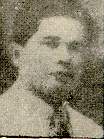
WENCESLAO Q. VINZONS
(1910 - 1942)
Wenceslao Vinzons was born on September 28, 1910, in Indan, Camarines Norte, to Gabino V. Vinzons and Engracia Quinito. He took his elementary education in his hometown and finished his secondary education at the Camarines Norte High School as valedictorian. He obtained his Bachelor of Laws from the University of the Philippines.
He was awardee of the Manuel L. Quezon gold medal for excellence for his oration entitled "Malaysia Irredenta" and the Abad Santos medal for excellence in debate. He was editor-in-chief of the UP’s Philippine Collegian, president of the student council, and member of the Upsilon Sigma Phi fraternity.
He seldom used his cars, preferring to take the Meralco bus to the university and back to his residence. This endeared him to his fellow students. Arturo M Tolentino, Ambrosio Padilla, Arturo B. Rotor, Amado G. Dayrit, Salvador P. Lopez, ad other eminent campus writers and leaders looked up to him.
In 1932, he led the youth movement in protest against the salary increase of the members of the Manila Municipal Council.
In 1933, he placed third in the bar examination. He won on a seat in the Constitutional Convention in 1934 at the age of 23. He was voted most outstanding young man in politics before the war. He founded the Young Philippines Party.
He was one of those responsible for making Tagalog the national language of the Filipinos. In the 1935 elections, he supported General Emilio Aguinaldo for presidency against President Manuel L. Quezon. He went from province to province explaining the necessity of having a balanced two-party system to prevent abuses, corruption and inefficiency in governmental affairs.
His scathing attack led to his prosecution for the crime of libel and sedition. He was judged guilty by the Court of First Instance of Cavite but was aquited by the Court of Appeals.
In 1940, he became Governor of Camarines Norte. He was noted for his adult education among the masses. In 1941, he was elected Congressman of his province.
At the outbreak of the World War II, he organized the first guerilla unit, the Citizen’s Army and the Vinzon’s Guerilla in the Bicol Region. He fought he enemy at Laniton and Tigbinan on December 17, 1941.On July 8, 1942, the Japanese, guided by an informer, a former guerilla named Villaluz, discovered his hideout. He was captured together with his father. He and his companions were paraded around the town of Labo. At the plaza, the Japanese prodded him to persuade the people to cooperate with the Japanese administration. "I have only three things to tell you," he said, "Plant! Plant! Plant!" This speech infuriated his captors. The prisoners were brought to the Daet garrison.
On July 15, 1942, Major Tsuneoke Noburo, the garrison commander, confronted him in a last attempt to enlist his services for the interests of Japan’s co-prosperity sphere. He had a piece of paper in hand. "This paper," he roared ominously, handing it to him, "Fifty Hiripin petitiong. You read."
He did not budge from his seat. "I know", he answered. "I have read it twice. They are asking you to execute me." "Fifty peopoor say you dorobo (bandit). I kirr dorobo." "I have not had a trial", he said. "The Geneva Convention says enemy soldiers captured are not to be killed." "You terr where your men go. Where Americans go." "Your captain, Azano, captured me in the mountains. I do not know where my men or where their guns are now." The Japanese commander shrieked "You rie! You rie!" and slapped him across the face. "You know. Your wife, she rie! She die! I kirr you too!"
He answered quietly. "Nothing can make me happier than to die for my country, major. You will die too…" Tsuneoka thrust his bayonet into Vinzon’s stomach. A Japanese corporal, Kuzumi Taiku, hit the helpness resistance leader with a rifle butt at the back of the head.
He was killed together with his wife, Liwayway Gonzales, his father, a sister, and two children. Their remains have never been recovered.
His hometown Indan, was renamed after him. In Manila, near Blumentritt, a school is named Wenceslao Elementary School. The students center of UP bears his name.












